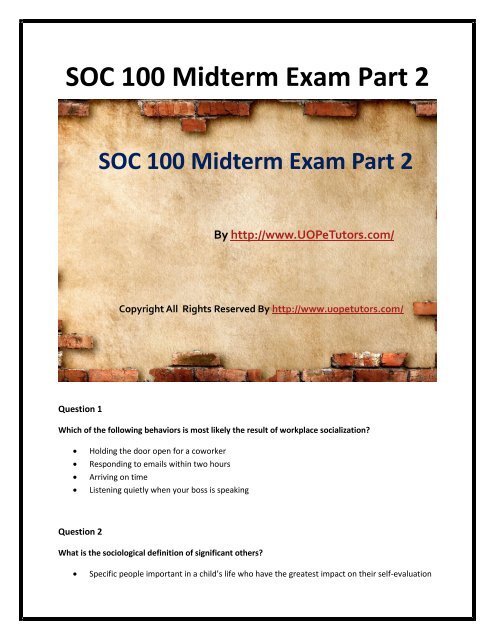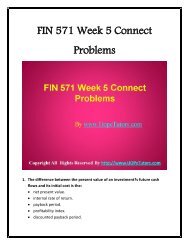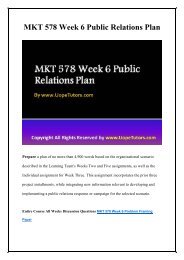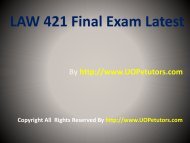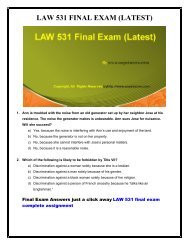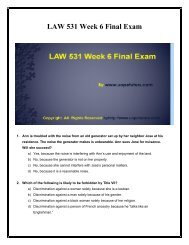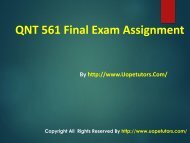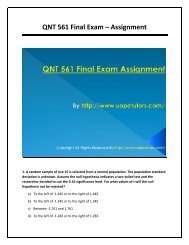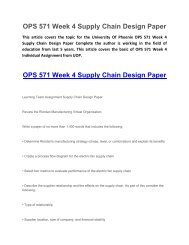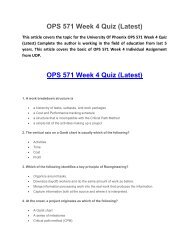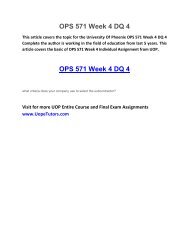SOC 100 Midterm Exam Part 2 Assignment
Prepare now with SOC 100 Midterm Exam Part 2 Answers and build your world of creativity and brilliance.
Prepare now with SOC 100 Midterm Exam Part 2 Answers and build your world of creativity and brilliance.
Create successful ePaper yourself
Turn your PDF publications into a flip-book with our unique Google optimized e-Paper software.
<strong>SOC</strong> <strong>100</strong> <strong>Midterm</strong> <strong>Exam</strong> <strong>Part</strong> 2<br />
<strong>SOC</strong> <strong>100</strong> <strong>Midterm</strong> <strong>Exam</strong> <strong>Part</strong> 2<br />
By http://www.UOPeTutors.com/<br />
Copyright All Rights Reserved By http://www.uopetutors.com/<br />
Question 1<br />
Which of the following behaviors is most likely the result of workplace socialization?<br />
<br />
<br />
<br />
<br />
Holding the door open for a coworker<br />
Responding to emails within two hours<br />
Arriving on time<br />
Listening quietly when your boss is speaking<br />
Question 2<br />
What is the sociological definition of significant others?<br />
<br />
Specific people important in a child’s life who have the greatest impact on their self-evaluation
Relationships characterized by intense emotional ties, face-to-face interaction, intimacy, and a<br />
strong, enduring sense of commitment<br />
Those whose opinions provide the basis for how we judge our own attitudes or behaviors<br />
People of similar age and social standing that influence our norms and values<br />
Question 3<br />
The study of social interaction as if it were governed by the norms of theatrical performance is<br />
referred to as:<br />
<br />
<br />
<br />
<br />
Presentation of self<br />
Theatrical socialization<br />
Dramaturgical approach<br />
Shakespearean social interaction<br />
Question 4<br />
The unspoken classroom socialization to the norms, values, and roles of a culture that school provides<br />
is referred to as:<br />
<br />
<br />
<br />
<br />
Textbook socialization<br />
Socialization curriculum<br />
Curriculum of inequality<br />
Hidden curriculum<br />
Question 5<br />
Which of the following behaviors is most likely the result of family socialization?<br />
<br />
<br />
<br />
<br />
Texting and holding a face-to-face conversation at the same time<br />
Standing during the playing of the national anthem<br />
Arriving to an important appointment 15 minutes early<br />
Performing specific household chores<br />
Want <strong>SOC</strong> <strong>100</strong> midterm exam part 2 answer download now <strong>SOC</strong> <strong>100</strong> <strong>Midterm</strong> <strong>Exam</strong> <strong>Part</strong> 2<br />
Question 6<br />
Adopting the behavior or standards of a group you emulate or hope to join is referred to as:
Conformity<br />
Clique socialization<br />
Anticipatory socialization<br />
Pro-active conformity<br />
Question 7<br />
The ability of groups to exclude outsiders participating in the group or enjoying group resources is<br />
referred to as:<br />
<br />
<br />
<br />
<br />
Social exclusion<br />
Social closure<br />
Factioning<br />
Clique capacity<br />
Question 8<br />
The idea that there exists an overarching structure within which culture and other aspects of society<br />
can be understood is referred to as:<br />
<br />
<br />
<br />
<br />
Structural functionalism<br />
Cultural structuralism<br />
Structuralism<br />
Institutionalism<br />
Question 9<br />
A(n) _____ organization is rationally designed to achieve particular objectives by means of explicit<br />
rules, regulations, and procedures.<br />
<br />
<br />
<br />
<br />
rational<br />
institutional<br />
formal<br />
official<br />
Question 10<br />
Power that depends on the ability to persuade rather than command is referred to as:
Personal power<br />
Persuasive legitimacy<br />
Persuasive authority<br />
Personal credibility<br />
Want more details? About <strong>SOC</strong> <strong>100</strong> click now <strong>SOC</strong> <strong>100</strong><br />
Question 11<br />
Power that depends on the leader’s role in the group is referred to as:<br />
<br />
<br />
<br />
<br />
Official power<br />
Legitimate authority<br />
Positional power<br />
Positional authority<br />
Question 12<br />
Which of the following examples illustrates groupthink?<br />
<br />
<br />
<br />
<br />
Weary from debating, a committee elects to put aside the topic until the next meeting.<br />
A high school basketball team follows their coach’s orders and adheres to a 10 p.m. curfew.<br />
After hearing feedback from constituents, a city council decides to pass a bill.<br />
An advertising agency decides to air an ad that received positive comments in pre-screenings,<br />
despite concerns that it was racially offensive.<br />
Question 13<br />
The act of having multiple wives is referred to as:<br />
<br />
<br />
<br />
<br />
Monogamy<br />
Mormonism<br />
Polygamy<br />
Polyandry<br />
Question 14<br />
According to Émile Durkheim, what condition occurs when people lose sight of the shared rules and<br />
values that give order and meaning to their lives?
Normlessness<br />
Anomie<br />
Strain<br />
Value tension<br />
Question 15<br />
Theories that identify the conflicting interests of certain segments of the population are referred to<br />
as:<br />
<br />
<br />
<br />
<br />
Conflict theories<br />
Subcultural theories<br />
Cultural theories<br />
Subgroup theories<br />
Complete <strong>SOC</strong> <strong>100</strong> midterm exam part 2 questions and answers click here to download <strong>SOC</strong> <strong>100</strong><br />
<strong>Midterm</strong> <strong>Exam</strong> <strong>Part</strong> 2<br />
Question 16<br />
The theory that people differ not only in their motivation to engage in deviant acts but also in their<br />
opportunity to do so is referred to as:<br />
<br />
<br />
<br />
<br />
Strain theory<br />
Opportunity theory<br />
Life chances theory<br />
Deviant prospects theory<br />
Question 17<br />
The argument that deviant behavior is little more than a product of the labels people attach to certain<br />
types of behavior is referred to as:<br />
<br />
<br />
<br />
<br />
Catalogue theory<br />
Association theory<br />
Labeling theory<br />
Criminal label theory<br />
Question 18
The idea that conflicts generated by fundamental contradictions in the structure of society produce<br />
laws defining certain acts as deviant or criminal is referred to as:<br />
<br />
<br />
<br />
<br />
Strain theory<br />
Societal contradiction theory<br />
Structural conflict theory<br />
Structural contradiction theory<br />
Question 19<br />
Which of the following is the best sociological definition of income?<br />
<br />
<br />
<br />
<br />
An individual’s yearly salary<br />
Wages, tips, and other compensation<br />
The amount of money a person or household earns in a given period of time<br />
The value of everything a person owns, minus the value of everything he or she owes<br />
Question 20<br />
The upward or downward status movement of individuals or groups over time is referred to as:<br />
<br />
<br />
<br />
<br />
Social progression<br />
Cultural promotion<br />
Social mobility<br />
Socioeconomic stasis<br />
<strong>SOC</strong> <strong>100</strong> complete paper here <strong>SOC</strong> <strong>100</strong><br />
Question 21<br />
Areas that lack places that sell competitively priced, healthy, and fresh food are referred to as:<br />
<br />
<br />
<br />
<br />
Food wastelands<br />
Grocery deserts<br />
Food deserts<br />
Food insecure regions<br />
Question 22<br />
A society in which personal success is based on talent and individual effort is referred to as:
Capitalist<br />
Westernized<br />
Meritocracy<br />
Achievement-based<br />
Question 23<br />
A person’s economic position in society, based on differences in income, wealth, and occupation, is<br />
referred to as:<br />
<br />
<br />
<br />
<br />
Caste<br />
Socioeconomic category<br />
Class<br />
Social classification<br />
Question 24<br />
_____ refer to people who share a common characteristic without necessarily interacting or<br />
identifying with one another.<br />
<br />
<br />
<br />
<br />
Social classes<br />
Social groups<br />
Subcultures<br />
Social categories<br />
Question 25<br />
A disparity in income, wealth, power, prestige, and other resources is referred to as:<br />
<br />
<br />
<br />
<br />
Social stratification<br />
Social inequality<br />
Class differences<br />
Class status<br />
Find the <strong>SOC</strong> <strong>100</strong> midterm exam 1 solution here <strong>SOC</strong> <strong>100</strong> <strong>Midterm</strong> exam 1
About Author:<br />
This article covers the topic for the Strayer University <strong>SOC</strong> <strong>100</strong> <strong>Midterm</strong> <strong>Exam</strong> <strong>Part</strong> 2. The author is<br />
working in the field of education from last 5 years. This article covers the basic of <strong>SOC</strong> <strong>100</strong> <strong>Midterm</strong><br />
<strong>Exam</strong> <strong>Part</strong> 2 from Strayer University. Other topics in the class are as follows:<br />
<strong>SOC</strong> <strong>100</strong> <strong>Midterm</strong> <strong>Exam</strong> <strong>Part</strong> 1<br />
<strong>SOC</strong> <strong>100</strong> <strong>Midterm</strong> <strong>Exam</strong> <strong>Part</strong> 2<br />
Want to check other classes..?? Visit www.UOPeTutors.com


